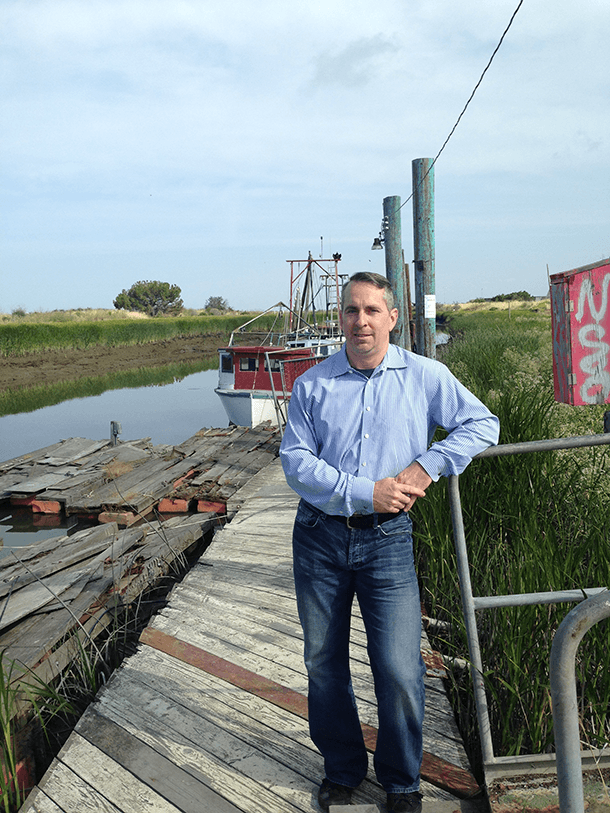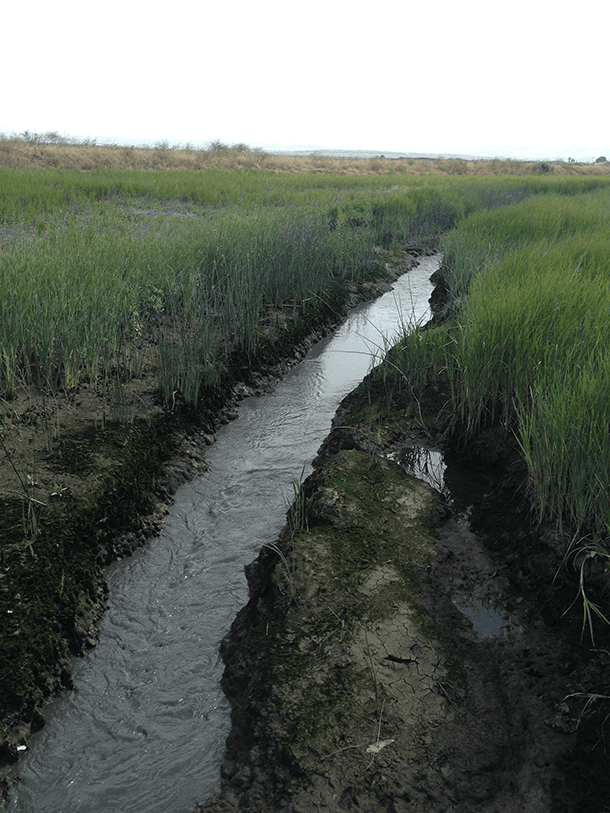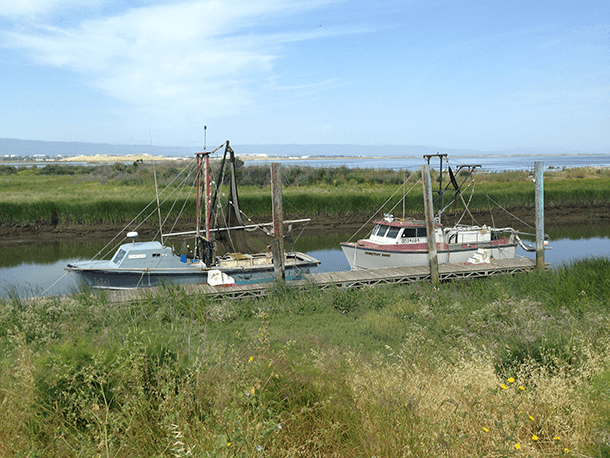Bay Area voters are being asked to pay more taxes to rebuild lost wetlands
Before the salt ponds reduced the flow of water, Alviso used to be a big fishing port.
Scientists and urban planners in the San Francisco Bay Area say restoring the bay’s once abundant wetlands could be the key to preparing for sea level rise.
On June 7, residents will vote on Measure AA, a $12-per-year parcel tax that would fund marsh restoration throughout the region.
The Bay Area isn’t as vulnerable to rising seas as cities like New Orleans and Miami, but it should expect to see four to six more feet of seawater by 2100. That’s according to Kristina Hill, a professor of landscape architecture and urban planning at UC Berkeley. Hill says the kneejerk reaction most people have to sea level rise is just to build walls to keep the ocean out. But that can't always work.
“What I try to do is help people go beyond that idea of the wall,” she says.
Sea walls are expensive, ugly, and they can’t be adjusted to changing conditions. Instead, Hill advocates building what she calls a “cyborg edge” — mechanical infrastructure blended with a living zone made up of sand bars and marshes. Scientific research has shown that wetlands can help protect cities from the sea by reducing the height of waves before they hit the shore.
“They’ve shown that as little as 200 feet of wetland verge can reduce wave height before those waves hit the dry land,” she says. “So that means less flooding, and that means a lower levee has to be built. Some kind of earthen berms will have to be a part of the system, but they can be lower and cheaper if we do the wetlands.”

In the southern part of San Francisco Bay, wetland restoration is already underway. John Bourgeois, the executive project manager for the California Coastal Conservancy’s South Bay Salt Pond Restoration Project, says the entire coastline around the bay used to be wetlands. Today 85 to 90 percent of the tidal marshes are gone. Some were paved over for coastal development, others were filled in for agriculture, and starting in the 19th century, many were turned into salt evaporation ponds.
“Little mom and pop salt-making operations would come around and they would levee off areas of wetland, flood them up, and evaporate the water and harvest the salt,” says Bourgeois, “and that became a bigger and bigger industry to where now the north and south bay are dominated by this salt pond landscape. It accounted for quite a bit of wetland loss.”
Unlike a parking lot, a salt pond can be deconstructed and turned back into a marsh. In 2003, the government secured rights to 15,000 acres of former salt ponds in the South Bay from companies like Cargill. Bourgeois and his organization are working to return these salt ponds back to marshland. “We undo what the salt companies did years ago,” he says. “We take down the levees, restore the hydrology back to the old remnant channels, and then just let nature take over.”
Bourgeois admits it’s not quite as simple as just getting out of nature’s way. In the 150 years since the salt production began, birds like the Western snowy plover have grown to like the salt ponds. The snowy plover is a federally threatened species, and he says they need to maintain habitat for birds like the plover as they restore wetlands that will benefit lots of other birds.
So far, Bourgeois and his team have restored 3,700 acres of former wetlands, about 25 percent of their ultimate goal. The biggest obstacle is finding a consistent source of funding; they’ve depended on a jumble of small federal and state grants, but that could soon change.
If Measure AA passes, every landowner pays a small fee for their parcel of land, with the funds going to wetland restoration throughout the Bay Area. Where exactly that money would go has yet to be determined, but the Salt Pond Restoration Project is exactly the kind of initiative the tax is supposed to fund.
Proponents say the tax would raise roughly $25 million a year for the next 20 years. David Lewis, director of the organization Save the Bay, says that money could accomplish 15,000 to 20,000 acres of tidal marsh restoration. Under measure AA, all property owners in the nine counties that touch the Bay would have to pay $12 a year to help restore the wetlands.
“Everybody who owns a parcel of land can afford to pay a dollar a month to help make the Bay healthier, and help make our community stronger and more resilient for decades to come,” says Lewis.
But not everyone in the environmental community thinks the tax is fair. Brian Beveridge is the co-director of the West Oakland Environmental Indicators Project, an environmental justice organization in West Oakland, a mostly low-income neighborhood beside the city’s port.

He says parcel taxes are notoriously regressive: A working class homeowner in West Oakland will pay the same amount as a giant tech company in Silicon Valley. Beveridge is all for restoring the bay, but he says the public shouldn’t have to pay for it.
“The very people who lost their shoreline in the first place are now being asked to pay to get it back. We do this consistently — we ask the victims of a wrong to pony up and pay to fix it.”
Beveridge works to reduce the impacts of pollution on people living in West Oakland, and his organization follows the "polluter pays principle," which says the company or organization that caused environmental damage should pay to clean it up. “So if it was this great expansion of private development along the shoreline that caused the problem in the first place,” he says, “maybe we should go back to the private sector and say, ‘hey, the chickens have come home to roost.’”
Getting companies to pay for wetland restoration is not a totally new idea. In Louisiana, environmental groups have brought lawsuits to try to force oil and gas companies to pay for the restoration of coastal wetlands that they helped to destroy. Those lawsuits are currently stuck in the courts facing fierce opposition from industry. But there hasn’t been a lawsuit in the Bay Area, and landscape architecture professor Kristina Hill says the government needs to find these funds as quickly as possible if it wants to avoid the worst effects of sea level rise.
Wetlands need time to develop, and the longer we wait the more adaptation is going to cost, she says. “That’s why I try to emphasize that we need … to borrow now and we need to spend now,” Hill says, “because if we wait until there’s disaster all around the world all at once, money is going to be very expensive to borrow and materials are going to be very much in short supply.”
If we fail to get ahead of the problem, she says, future generations will be stuck shouldering much larger costs. “I think that’s an intergenerational inequality that we really should own up to,” she says.
If measure AA passes, it will be the first time that a major metropolitan area has voted to spend taxpayer money to prepare for sea level rise. With so many US cities along the coast vulnerable to rising seas, it could well be a model for the future.
This story first aired as an interview on PRI's Living on Earth.
